
Vegetable garden mulch experiments
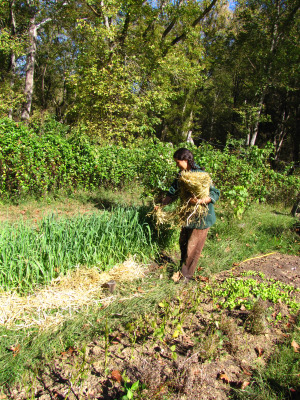 One
of our goals for 2010 was constant mulch cover in the vegetable
garden. We didn't get there, mostly because I got so caught up in
weeding in the middle of the summer that I forgot I could have been
spending half that time mulching and getting the same results.
But we did try out a lot of different mulching materials, discovering
in the process which ones work well for our garden.
One
of our goals for 2010 was constant mulch cover in the vegetable
garden. We didn't get there, mostly because I got so caught up in
weeding in the middle of the summer that I forgot I could have been
spending half that time mulching and getting the same results.
But we did try out a lot of different mulching materials, discovering
in the process which ones work well for our garden.
The easiest and best-suited
mulch (in terms of
C:N ratio and water infiltration) for the vegetable garden is straw, but straw costs an arm and
a leg in our non-grain-growing region. I have high hopes that we
will eventually be growing our own straw as part of our grain
experiments, but in the meantime, I wanted to see which free mulches
would work in its place.
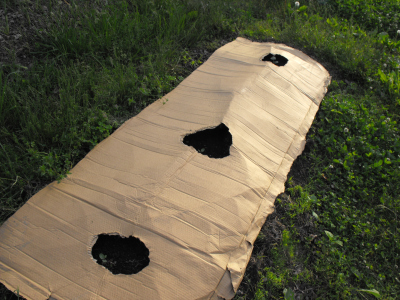 Cardboard showed a lot of promise
early in the season, but ended up keeping the soil too dry. In
the early summer, soil was wetter under the cardboard mulch than in
unmulched areas, but I suspect that was due to the cardboard preventing
evaporation of water that was already in the soil. Even though I
punched holes in the cardboard to promote infiltration of rainwater,
the cardboard-mulched beds started drying out by mid-summer. In
the fall, it was clear that the cardboard-mulched beds were bone dry,
and even our dry-soil-loving peppers started to wilt near the end of
the year. Cardboard seems to be more useful as part of sheet
mulches to delete weeds from new garden areas or from around woody
perennials, and I don't think I'll be using it in the vegetable garden
again.
Cardboard showed a lot of promise
early in the season, but ended up keeping the soil too dry. In
the early summer, soil was wetter under the cardboard mulch than in
unmulched areas, but I suspect that was due to the cardboard preventing
evaporation of water that was already in the soil. Even though I
punched holes in the cardboard to promote infiltration of rainwater,
the cardboard-mulched beds started drying out by mid-summer. In
the fall, it was clear that the cardboard-mulched beds were bone dry,
and even our dry-soil-loving peppers started to wilt near the end of
the year. Cardboard seems to be more useful as part of sheet
mulches to delete weeds from new garden areas or from around woody
perennials, and I don't think I'll be using it in the vegetable garden
again.
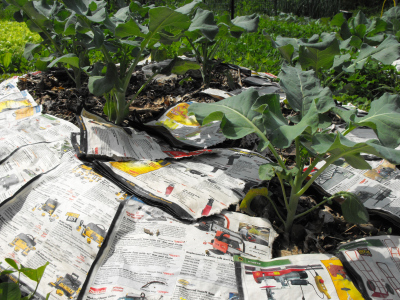 Paper was even less
promising. If we subscribed to the newspaper, we probably would
have had better luck, but the junk mail I mulched with had too high of
a percentage of colored dyes and glossiness, and the plants around the
paper mulch mostly died. I'd be curious to see if running the
paper through a shredder first would make it a slightly better mulch by
adding fluffiness and air pockets, but we'll probably use up our junk
mail in the worm bin and perhaps with mushrooms in the future.
Paper was even less
promising. If we subscribed to the newspaper, we probably would
have had better luck, but the junk mail I mulched with had too high of
a percentage of colored dyes and glossiness, and the plants around the
paper mulch mostly died. I'd be curious to see if running the
paper through a shredder first would make it a slightly better mulch by
adding fluffiness and air pockets, but we'll probably use up our junk
mail in the worm bin and perhaps with mushrooms in the future.
We used tree
leaves as a winter mulch on most of the garden last
year, but they were a bit too high in carbon to be optimal for the
vegetable garden. This winter, we're using tree 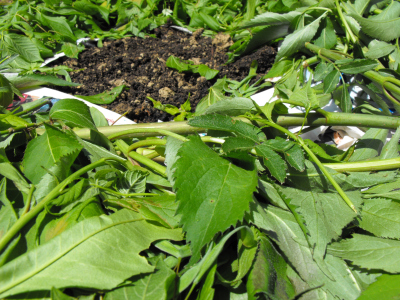 leaves
as bedding in the chicken coop, where they mix with manure and (I hope)
will turn into a perfect mulch by spring.
leaves
as bedding in the chicken coop, where they mix with manure and (I hope)
will turn into a perfect mulch by spring.
Green leaves --- like grass
clippings, elderberry
leaves, and comfrey
leaves --- are well suited to being used directly on the vegetable
garden as mulch, but each has flaws as well. Elderberry and
comfrey leaves work great, but it feels like the juice isn't worth the
squeeze unless I can find a quicker way of harvesting them, and grass
clippings are really only suitable in the spring before the plants
start to go to seed. I think that this year, I'm only going to
have Mark bag grass clippings for the first month or two, then let the
grass grow up in out of the way parts of the yard in late summer to use
as hay for the chickens.
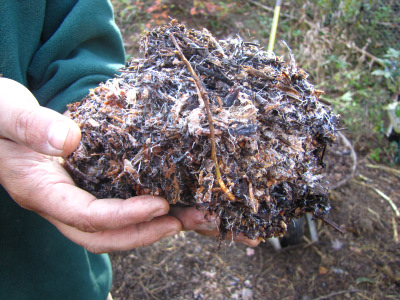 The
final mulch possibility is wood chips. Well aged wood
chips make the best
mulch for our woody plants, full of beneficial fungi and other soil
microorganisms. I suspect that wood chip mulch that has been well
worked over by the chickens and looks like it's halfway on its path to
becoming stump dirt would also make a perfect mulch for the vegetable
garden since chicken manure would keep this mulch from locking up
nitrogen in the soil. Unfortunately, I rarely have enough really
good (aka homemade) wood chip mulch for the trees and berries, let
alone for the vegetable garden.
The
final mulch possibility is wood chips. Well aged wood
chips make the best
mulch for our woody plants, full of beneficial fungi and other soil
microorganisms. I suspect that wood chip mulch that has been well
worked over by the chickens and looks like it's halfway on its path to
becoming stump dirt would also make a perfect mulch for the vegetable
garden since chicken manure would keep this mulch from locking up
nitrogen in the soil. Unfortunately, I rarely have enough really
good (aka homemade) wood chip mulch for the trees and berries, let
alone for the vegetable garden.
In 2011, we'll probably
continue to buy quite a bit of straw for the garden, but we'll
supplement it in the spring with grass clippings and with the deep
bedding from the chicken coop. In the long run, someday I'd like
to be making enough compost (from cafeteria food scraps?) and wood chip
mulch to keep the garden happy with entirely homemade mulches.
This post is part of our 2010 experiments lunchtime series.
Read all of the entries:
|
Want more in-depth information? Browse through our books.
Or explore more posts by date or by subject.
About us: Anna Hess and Mark Hamilton spent over a decade living self-sufficiently in the mountains of Virginia before moving north to start over from scratch in the foothills of Ohio. They've experimented with permaculture, no-till gardening, trailersteading, home-based microbusinesses and much more, writing about their adventures in both blogs and books.
Want to be notified when new comments are posted on this page? Click on the RSS button after you add a comment to subscribe to the comment feed, or simply check the box beside "email replies to me" while writing your comment.

Are you far enough south to grow sugar cane or rice? Some of the permaculture sites I visit swear by cane mulch and rice straw.
Some years back Hershey was giving away cocoa bean husks for mulch. Now, it's at a dear price.
With your wet area have you considered saw grass? It grows fairly fast and tall, and you can use it as fuel(with a still of course). There are several "crops" you could run through a still and use the mash as bio-mass and as I understand it, it tends to be good for keeping away unwanted pests from the next crop. As a benefit you get fuel for engines or heat too.
Just what you need, more food for thought. Thought, thought he thought a lot, but then he thought about it, and thought he ought to continue with his current train of thought.
vester
Vester --- nope. Here in zone 6, we can't grow either of those, although we could grow sorghum for molasses. Unfortunately, the main cash crops in our area (corn, cows, tobacco) don't make useful byproducts
We have considered putting the wet, low part of the powerline cut to use growing some sort of mulch for us (although I was considering comfrey), but we get bogged down in the fact that doing that would require a tractor, bushhog, etc., and for that price, we could just buy straw every year for the rest of our lives.
Rebecca --- Last year at this time, I was positive a chipper was going to be the golden bullet that solved the mulch problem. Then we rented a medium-sized industrial strength one with a friend and discovered just how little chipping happens per unit work and time. Since we wouldn't be able to afford anything nearly as big as the one we rented, I was forced to conclude that chipping our own wood wasn't going to be the solution.
On the other hand, we're working on becoming better buddies with the electric company tree chippers --- we already got two big piles of fresh chips and hope that more will be on the way...